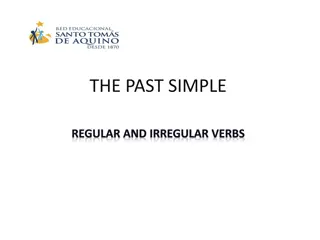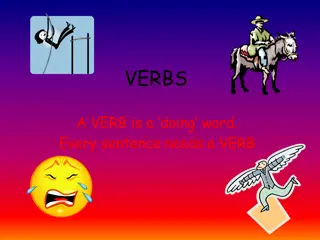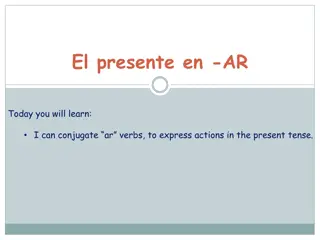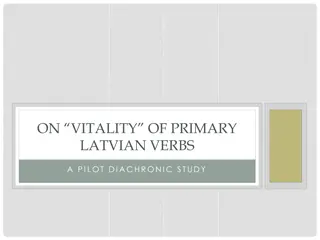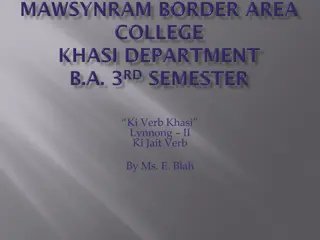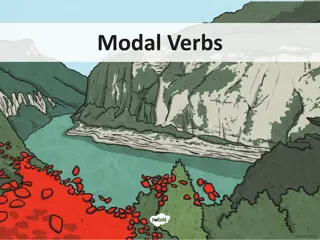Irregular Preterite Verbs
In Spanish 3, we explore more irregular preterite verbs and categorize their types. These verbs have no accents and various endings. Examples include "ir," "ser," "dar," and more. Learn about irregular verbs with common characteristics and irregular forms in different conjugations.
Download Presentation

Please find below an Image/Link to download the presentation.
The content on the website is provided AS IS for your information and personal use only. It may not be sold, licensed, or shared on other websites without obtaining consent from the author.If you encounter any issues during the download, it is possible that the publisher has removed the file from their server.
You are allowed to download the files provided on this website for personal or commercial use, subject to the condition that they are used lawfully. All files are the property of their respective owners.
The content on the website is provided AS IS for your information and personal use only. It may not be sold, licensed, or shared on other websites without obtaining consent from the author.
E N D
Presentation Transcript
Irregular Preterite Verbs Avancemos 3 Unidad 1 Lecci n 1
Irregular Preterite Verbs There are many types of irregular preterite verbs in Spanish. We saw some of them in Spanish 2 In Spanish 3, we will look at some more preterite verbs, as well as categorizing what type of preterite they are.
Irregular Verbs These are just plain old irregulars which means that there are really no set patterns. They do however have some things in common between them. These verbs have NO ACCENTS Some examples would include
IR - to go SER to be Fui Fuiste Fue Fuimos Fueron Fui Fuiste Fue Fuimos Fueron
Other Irregular Verbs The following verbs are also irregular. These also have some things in common between them. These verbs have NO ACCENTS They have the endings: i, iste, io, imos, ieron Some examples would include
DAR to give VER to see Di Diste Dio Dimos Dieron Vi Viste Vio Vimos Vieron
Other Irregular Verbs Y Verbs Y verbs are verbs that have accents in all forms EXCEPT for 3rdperson plural (ellos,ellas, ustedes). They also have a y in the 3rdperson singular and 3rdperson plural. Their endings are: , ste, y , mos, yeron These verbs include: Leer to read o r to hear Creer to believe
LEER to read or to hear le le ste ley le mos leyeron o o ste oy o mos oyeron
Other Irregular Verbs j Verbs j verbs are verbs that have an irregular stem with a j They also have irregular endings. Their endings are: e, iste, o, imos, ieron (NO ACCENTS) These verbs include: Traer (to bring) traducir (to translate) Conducir (to drive) decir (to say,to tell)
TRADUCIR to translate traduje tradujiste tradujo tradujimos tradujeron CONDUCIR to drive conduje condujiste condujo condujimos condujeron
TRAER to bring traje trajiste trajo trajimos trajeron DECIR to say/tell dije dijiste dijo dijimos dijeron
Other Irregular Verbs irregular endings and stems The following verbs have both irregular endings and irregular stems. Many of the stems contain the letter u in the stem while some have the letter i Their endings are: e, iste, o, imos, ieron (NO ACCENTS) These verbs include:
u stems Estar (estuv) Tener (tuv) Andar (anduv) Caber (cup) Poner (pus) Poder (pud) Saber (sup) To be To have To walk To fit in To put To be able to/can To know/find out
i stems Querer (quis) Venir (vin) ***Hacer (hic) To want/to try To come To do/to make *** NOTE l/ella/usted form of hacer is hizo
Other Irregular Verbs CAR/GAR/ZAR These verbs are irregular in the yo form only. All other forms use the ar verb preterite endings. The CAR verbs = c-qu (yo form only) The GAR verbs = g-gu (yo form only) The ZAR verbs = z-c (yo form only)
Other Irregular Verbs sole/sandal verbs These verbs are all ir verbs that are stem changers in the present tense. In the preterite they are also stem changers but in the 3rd person only ( l/ella/ud & ellos/ellas/uds.). They have the er/ir preterite endings. In the stems of the 3rd person, e changes to I and o changes to u.
Prctica 1. Usted andar 2. T leer 3. Felipe y yo poner 4. Ustedes ser 5. Yo traer 1. Usted anduvo 2. T le ste 3. Felipe y yo pusimos. 4. Ustedes fueron 5. Yo traje
Prctica Ellos condujeron Uds. siguieron Yo navegu T y ella creyeron 10. La clase dio 6. Ellos conducir 7. Uds. seguir 8. Yo navegar 9. T y ella creer. 10.La clase dar. 6. 7. 8. 9.










